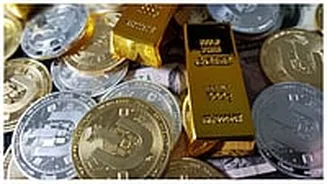Market's Downward Trend
Gold prices witnessed a decline on Monday, slipping beneath the ₹1.25 lakh mark for 10 grams in Mumbai. This movement echoed a broader global decrease,
fueled by a softening of trade tensions between the US and China. The easing of these tensions has bolstered investor confidence in riskier assets, such as stocks, diverting funds away from safe-haven assets like gold. This shift in sentiment was evident in the Asian stock markets, which experienced a rally, reflecting the optimistic outlook that a trade deal between the two nations was likely following preliminary discussions before their leaders' meeting in South Korea. The 24-carat gold was priced at ₹1,24,480 per 10 grams in the domestic market, whereas the 22-carat gold was valued at ₹1,15,140 per 10 grams. Furthermore, silver prices also decreased, settling at ₹1,54,900 per kilogram. Globally, spot gold fell by 1.3% to $4,059.22 an ounce, with US gold futures for December delivery dropping by 1.6% to $4,072.40. These rates are a noticeable drop from the record high of $4,381.21 achieved on October 20th, when geopolitical concerns and anticipated US rate cuts significantly elevated prices.
Trade Talks' Influence
The ongoing discussions between the US and China are significantly impacting the gold market. Positive developments in trade negotiations have led to improved risk appetite among investors, which, in turn, has diminished the demand for gold as a safe-haven asset. The prospect of a trade deal between the US and China has been identified as a key factor supporting riskier assets while simultaneously putting pressure on gold prices. Analysts have noted that the market's response to the situation has made gold less appealing. Moreover, some experts predict that the relaxation of tariffs could allow the Federal Reserve to implement further rate cuts. This optimism regarding trade, coupled with a strengthening US dollar, has contributed to the decline in gold prices. Key market participants were closely monitoring the situation. A possible trade agreement between the US and China is supporting risky assets and weighing on gold. The market is also heavily influenced by the expectations surrounding the Federal Reserve's policy decisions and statements.
Fed Policy's Role
The Federal Reserve's policy decisions are a crucial element influencing gold prices. Market participants are anticipating a 25-basis-point rate cut, and the focus is on the tone of Chair Jerome Powell's statement, seeking clues about the future policy direction. Analysts believe that the Federal Reserve's signals regarding rate cuts will significantly influence profit-taking in the gold market. In a low-interest-rate environment, gold typically benefits as investors seek refuge in assets that preserve value, and any indication of further rate cuts could lead to a resurgence in gold prices. The market's anticipation of future policy changes by the Federal Reserve is currently playing a crucial role in shaping the gold market's landscape. A pivotal factor being watched this week is the announcement from the US Federal Reserve, in addition to the meetings between US President Donald Trump and Chinese President Xi Jinping. Investors should be ready for fluctuations and sharp price swings.
Expert Insights
Industry experts provide valuable perspectives on the market's dynamics. Darshan Desai, CEO of Aspect Bullion & Refinery, noted that the weakening of safe-haven demand, due to optimism over a potential US-China trade deal and a stronger US dollar, is contributing to the price decline. UBS analyst Giovanni Staunovo suggested that while trade talk optimism is negatively affecting gold prices, the possibility of continued monetary easing remains a supportive factor in the medium term. He also suggested that a possible trade deal between the US and China is supporting risky assets and weighing on gold, but we should also remember that potentially lower tariffs will allow the Federal Reserve to cut rates further. These insights highlight the complex interplay of various factors that influence gold prices, providing investors with a more comprehensive understanding of the market.


















